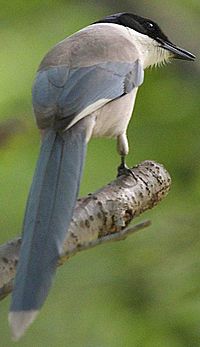- Azure-winged Magpie
-
Azure-winged Magpie Scientific classification Kingdom: Animalia Phylum: Chordata Class: Aves Order: Passeriformes Family: Corvidae Genus: Cyanopica
Bonaparte, 1850Species Cyanopica cyana Pallas, 1776
Cyanopica (cyana) cooki Bonaparte, 1850The Azure-winged Magpie (Cyanopica cyana) is a bird in the crow family. It is 31–35 cm long and similar in overall shape to the European Magpie (Pica pica) but is more slender with proportionately smaller legs and bill. It belongs to the monotypical genus Cyanopica.
It has a glossy black top to the head and a white throat. The underparts and the back are a light grey-fawn in colour with the wings and the feathers of the long (16–20 cm) tail are an azure blue. It inhabits various types of coniferous (mainly pine) and broadleaf forest, including parks and gardens in the eastern populations.
It occurs in two population groups separated by a huge geographical region between. One population lives in Western Europe, specifically the southwestern part of the Iberian Peninsula, in Spain and Portugal. The other population occurs over a much larger region of eastern Asia in most of China, Korea, Japan, and north into Mongolia. Recent genetic analysis has shown that the two populations are distinct at species level,[1] under which the Iberian Azure-winged Magpie would take the name Cyanopica cooki, though this change has yet to be formally incorporated in the European bird list.
Often Azure-winged Magpies find food as a family group or several groups making flocks of up to 70 birds. The largest groups congregate after the breeding season and throughout the winter months. Their diet consists mainly of acorns (oak seeds) and pine nuts, extensively supplemented by invertebrates and their larvae, soft fruits and berries, and also human-provided scraps in parks and towns.
This species usually nests in loose, open colonies with a single nest in each tree. There are usually between 6–8 eggs that are incubated for 15 days.
The voice is a quick fired and metallic sounding kwink-kwink-kwink usually preceded by a single krarrah.
Gallery
-
Drawing by Peter Simon Pallas
References
- ^ Kyukov et al, Synchronic east–west divergence in azure-winged magpies (Cyanopica cyanus) and magpies (Pica pica, Journal of Zoological Systematics and Evolutionary Research 42(4): 342-351 (2004)
Extant species of family Corvidae Kingdom: Animalia · Phylum: Chordata · Class: Aves · Subclass: Neornithes · Superorder: Neognathae · Order: PasseriformesFamily Corvidae Choughs Treepies PlatysmurusTemnurusOriental
magpiesOld World jays PtilostomusStresemann's
BushcrowZavattariornis
Categories:- Cyanopica
- Monotypic bird genera
- Animals described in 1776
Wikimedia Foundation. 2010.
Look at other dictionaries:
azure-winged magpie — mėlynosios šarkos statusas T sritis zoologija | vardynas atitikmenys: lot. Cyanopica angl. azure winged magpie vok. Blauelster, f rus. голубая сорока, f pranc. pie bleue, f ryšiai: platesnis terminas – varniniai siauresnis terminas – azijinė… … Paukščių pavadinimų žodynas
Asian azure-winged magpie — azijinė mėlynoji šarka statusas T sritis zoologija | vardynas atitikmenys: lot. Cyanopica cyanus angl. Asian azure winged magpie vok. Azurelster, f rus. голубая сорока, f pranc. pie bleue à calotte noire, f ryšiai: platesnis terminas – mėlynosios … Paukščių pavadinimų žodynas
Iberian azure-winged magpie — iberinė mėlynoji šarka statusas T sritis zoologija | vardynas atitikmenys: lot. Cyanopica cooki angl. Iberian azure winged magpie vok. Blauelster, f pranc. pie bleue ibérique, f ryšiai: platesnis terminas – mėlynosios šarkos … Paukščių pavadinimų žodynas
Azure Jay — Conservation status Near Threatened (IUCN 3.1) … Wikipedia
Azure-naped Jay — Conservation status Least Concern ( … Wikipedia
Magpie-jay — Magpie jays White throated Magpie Jay, Calocitta formosa Scientific classification Kingdom: Animalia … Wikipedia
Magpie — This article is about the birds in the family Corvidae. For the Australasian bird in the family Artamidae, see Australian Magpie. For other uses, see Magpie (disambiguation). Magpies European Magpie … Wikipedia
Azure-hooded Jay — Azure hooded Jay … Wikipedia
Magpie (disambiguation) — Contents 1 Birds 2 Fish 3 Moths 4 Places … Wikipedia
European Magpie — In Helsinki, Finland … Wikipedia






